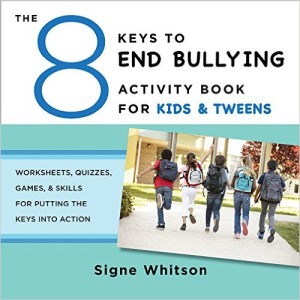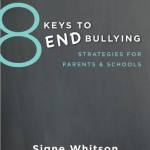Archive for January, 2017
New Reviews are In for the 8 Keys to End Bullying Activity Book
0
 “A needed topic in a great format. It is an Activity Book and more! The author uses a variety of methods to communicate her key points. Drawing for the artist, writing for the wordsmith, up and at ’em for the active learner. Each key has a checkpoint (post test) to determine comprehension. The stories use culturally relevant names and situations which I find helpful working with the population I do. I especially like Key 6,Be Known For Being Kind, which give 10 things to say and do to stop bullying. New ideas allow for independent thinking and actions and it doesn’t even list “tell an adult” which most kids say doesn’t work. Thanks, Ms. Whitson for a great resource.”
“A needed topic in a great format. It is an Activity Book and more! The author uses a variety of methods to communicate her key points. Drawing for the artist, writing for the wordsmith, up and at ’em for the active learner. Each key has a checkpoint (post test) to determine comprehension. The stories use culturally relevant names and situations which I find helpful working with the population I do. I especially like Key 6,Be Known For Being Kind, which give 10 things to say and do to stop bullying. New ideas allow for independent thinking and actions and it doesn’t even list “tell an adult” which most kids say doesn’t work. Thanks, Ms. Whitson for a great resource.”
The activities are fun to do and I couldn’t wait to see what was coming next. After I completed the 8 Keys I really wanted to get rid of bullying at my school. I learned what bullying is and things I can do to stop it.” (Ashlyn, age 11)
“Signe Whitson continues to be one of the most dynamic leaders in bullying education and crisis intervention among youth. These interactive guides for students, parents, and educators provide the hands-on tools to help kids and tweens cope wisely with real-life situations, both offline and online. These workbooks are full of engaging and collaborative games, worksheets, and thought-provoking activities that will stay with your child longer than simply reading a book. Whitson’s activity program allows you to get involved with your child on both an emotional level and an educational one―these are definitely two books you must reach out and buy.” (Sue Scheff, Parent Advocate, Internet Safety Expert and author of Shame Nation)
“Well-organized and easily relatable, this workbook and companion guide will help kids understand categories of aggressive behaviors―such as how rude, mean, and bullying behaviors differ―and teach them to treat others with respect and kindness. Bravo for a fun, accessible anti-bullying activity program!” (Carrie Goldman, award-winning author of Bullied: What Every Parent, Teacher, and Kid Needs to Know About Ending the Cycle of Fear)
“Signe Whitson continues to provide value that very few do: a detailed approach that offers tools and skill-building for young people in an action-based training format. This is the only way to impact one of our toughest issues that all people face: bullying. An amazing resource for educators and parents, with proven strategies to fight bullying situations.” (Jason Spector, Veteran Physical Educator and Coach, Co-Founder of Sweethearts and Heroes Anti-Bullying Program, father of two)
Thanks, all, for your kind words and great feedback! If you have not uploaded our review yet, please do so at https://www.amazon.com/Keys-Bullying-Activity-Book-Tweens/dp/0393711803/ref=pd_bxgy_14_img_2?_encoding=UTF8&pd_rd_i=0393711803&pd_rd_r=ZNTF9NXEC95WBS47H7CM&pd_rd_w=x1GW6&pd_rd_wg=jFlBe&psc=1&refRID=ZNTF9NXEC95WBS47H7CM
Fun Activity Helps Kids Tell the Difference Between Bullying and Other Forms of Conflict & Aggression
0In my book, 8 Keys to End Bullying: Strategies for Parents & Schools and in this article featured online in Psychology Today, I make a distinction between behaviors that are rude, behaviors that are mean, and  behaviors that are true examples of bullying. I explain why it is critical that parents and professionals are able to discern the differences between these troubling behaviors and explain the risks of lumping all bad behaviors under the bullying umbrella.
behaviors that are true examples of bullying. I explain why it is critical that parents and professionals are able to discern the differences between these troubling behaviors and explain the risks of lumping all bad behaviors under the bullying umbrella.
I created the activity below for educators, counselors. social workers, school psychologists, youth workers and parents to use with kids to help them learn and integrate behavioral definitions of rude, mean, and bullying. Please feel free to use this activity with the young people in your life to teach them about the key distinctions between these three behaviors. (I do ask that you include my name and contact information if you make photocopies of this activity or use it in any type of presentation.
ACTIVITY: Is it Rude, Is it Mean, or Is it Bullying?
After reviewing the distinctions between rude, mean, and bullying behavior (below), read the following scenarios aloud to kids. Challenge kids to move to a designated section in the room if the behavior represents bullying, to a different section if the behavior demonstrates meanness, and to a third section if the behavior is considered rude. Allow kids time to discuss why they chose to stand in a particular section, encouraging personal examples and reflection, as appropriate. An Answer Key is provided to guide your discussion.
DEFINITIONS:
Rude = Accidentally saying or doing something hurtful.
Rude behaviors include:
- Burping in someone’s face
- Butting in line
- Bragging about making a team
Rude behaviors are usually thoughtless and ill-mannered, but not meant to actually hurt someone else.
Mean = Saying or doing something to hurt a person on purpose, once or maybe twice.
The main difference between “rude” and “mean” behavior is that rudeness is usually unplanned. Mean behavior, on the other hand, is done on purpose.
Mean behaviors include:
- Making fun of what someone looks like or what they are wearing
- I don’t like your short hair. You look like a boy.
- Why did you wear that dress?
- Insulting someone’s intelligence or ability
- You’re so stupid.
- You stink at soccer.
- Saying or doing something unkind after a fight with a friend.
- Saying, “I hate you.”
- Taking something that doesn’t belong to you.
Make no mistake; mean behaviors are very hurtful and should be avoided at all times! Still, meanness is different from bullying in important ways that we’ll talk about next.
Bullying = Cruel behavior, done on purpose and repeated over time, that involves an imbalance of power.
To best understand bullying, remember the 3 P’s:
- It is done on Purpose; there is nothing “accidental” or unplanned about bullying
- It is a Pattern; the cruelty happens over and over again
- It is all about Power; the cruel person has more control and influence than his/her target
Kids who bully say or do something purposefully hurtful to others and they keep doing it again and again, with no sense of guilt or shame. Kids who bully have more power than the kids they pick on. This power may come from being older, stronger, or bigger in size or it may come from getting several kids to gang up on one target, to make that target feel hurt and alone.
SCENARIOS:
- Kayla tells MacKenzie that she can’t sit with her on the bus today because she is saving the seat for a girl from her Social Studies class.
- Lucas tells Damien that he can’t play with the Legos because he is the worst builder in the whole first grade.
- Talia makes plans to go to the school dance with her new friend, Gwen. Katie tells Talia that if she hangs out at the dance with Gwen that everyone will think she is a total weirdo and no one will like her anymore. At lunch that day, Katie convinces everyone that it would be a really funny joke to all laugh out loud when Talia approached the lunch table.
- Devin and David are friends. In school, they had an argument. Devin called David a name and David shoved him out of his way.
- Maggie is making fun of the fact that Jessie hangs out with the boys at recess and wears long basketball shorts to school every day. In gym class, Maggie told her to go play on the boys’ team and the day before in homeroom, she wrote the words “You’re so gay” on Jessie’s desk.
- Brady told JP he would beat him up if he touched his cars, then shoved JP out of his way. During math class, he threw a spitball at JP and kicked his chair out from under him. He threatened to punch JP if JP told the teacher.
- Emma and Brit play on the same field hockey team and are normally best friends, but have been in an argument for three days. Emma called Brit a mean name after practice and Brit send Emma a mean text.
ANSWER KEY
- Kayla & MacKenzie: Kayla is being rude, but here is no evidence of intentional meanness, repetitive behavior or a power imbalance.
- Lucas & Damien: Lucas is being mean. It appears that his words are intended to hurt Damien. There is no evidence of repetitive behavior or a power imbalance, however.
- Talia & Katie: Katie is acting like a bully. She has creating an unfair balance of power by getting all of the girls at the lunch table to laugh at Talia. She is also using words like “everyone” and “no one” to threaten Talia about how she will be socially excluded if she does not do what Katie wants her to do.
- Devin & David: Devin and David are engaging in rough play, or rude behavior. This is not bullying because the boys are usually friends, the power balance is relatively equal and the boys are not intending to harm each other.
- Maggie & Jessie: Maggie is acting like a bully. She is making fun of Jessie repeatedly, with intention to cause harm. Slurs based on sexual orientation are particularly cruel for young people and should be taken seriously by adults wishing to create a positive school culture.
- Brady & JP: Brady is acting like a bully. He is engaging in repetitive cruel behavior, designed to hurt JP. He is using intimidation and threats to create a power imbalance.
- Emma & Brit: Emma and Brit are being mean to each other. They are intending to hurt each other with their words and texts. The girls are normally friends, though, and at this point, this appears to be a mutual argument rather than a repetitive pattern of one-sided cruelty.
If you know a young person who would benefit from exploring the distinctions between rude, mean, and bullying and/or who would like to learn skills for managing conflict and bullying check out the 8 Keys to End Bullying Activity Book for Kids & Tweens. This book (and Companion Guide, sold separately or as a set) provides dozens of worksheets, quizzes, activities, puzzles, and skill-building games to teach these concepts and much, much more. Check it out here!
